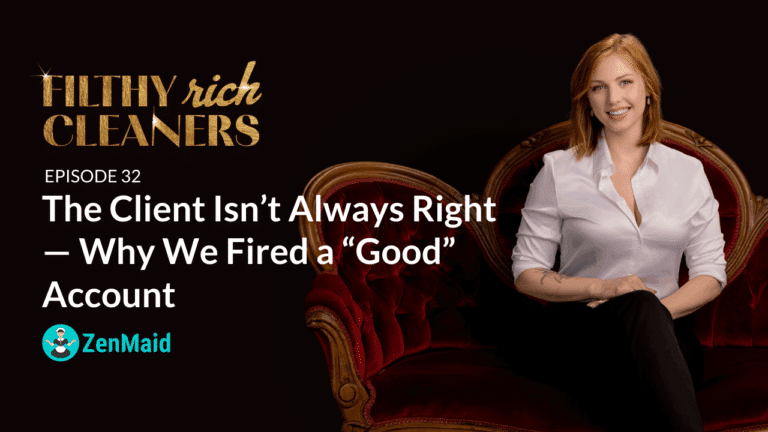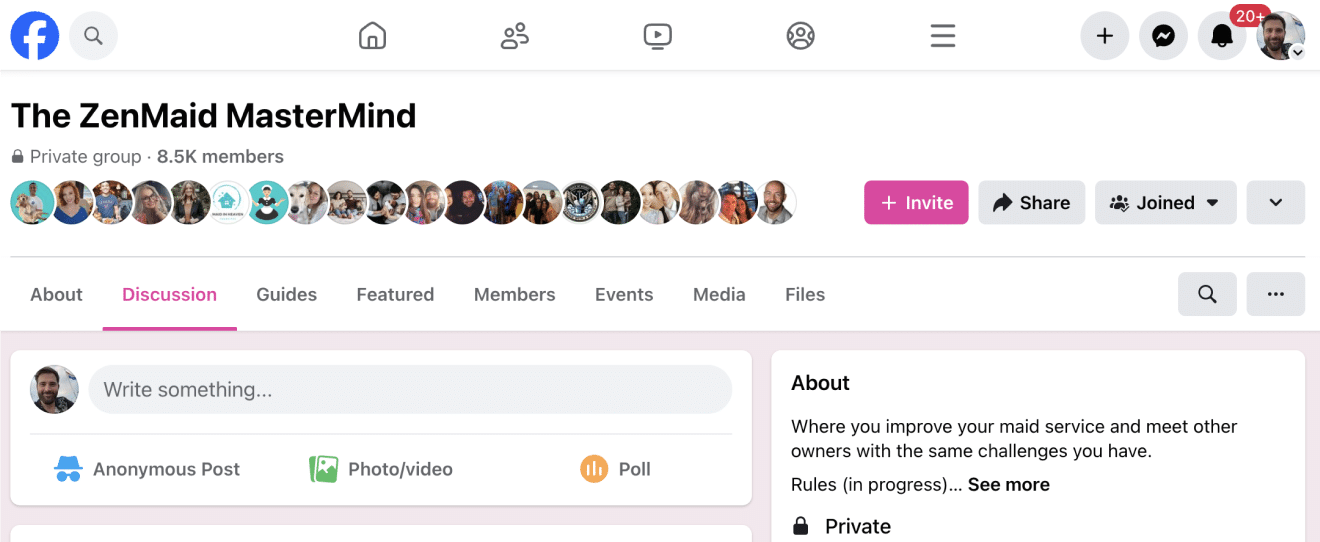
Brought to you by expert maid service owners
Introduction
Hello everyone. Welcome or welcome back to the Filthy Rich Cleaners podcast. I’m your host, Stephanie Pipkin from Serene Clean, and in today’s solo episode, I want to talk to you guys about opportunity cost. If you don’t know what opportunity cost is, from our Google AI overview, in simple terms, it’s what you give up when you choose one option over another.
The reason I want to bring this up is oftentimes what we are choosing is at the detriment of what we could be doing with that same time, opportunity, cleaning slot, whatever have you. We are putting ourselves in situations where we’re missing out on opportunities we’re not even aware of yet.
Table of contents
- Introduction
- The Library Problem: A Case Study
- The Library Problem: A Case Study
- When Price Increases Aren’t Accepted
- Red Flags Piling Up
- When Everyone Is Done
- Doing the Math
- Making the Hard Decision
- The Relief of Letting Go
- Defining Your Ideal Client
- What They Really Need
- Identifying Ideal Clients
- The Learning Process
- Setting Boundaries and Rules
- Overcoming the Fear of Difficult Decisions
- Having Faith in Your Systems
- The Decision to Let Go
- The Two Key Areas of Focus
- Learning from Mistakes
- The True Cost of Indecision
- The Ripple Effect of Bad Decisions
- Making the Hard Choices
- Taking Action
- Moving Forward with Confidence
- Closing Thoughts
The Library Problem: A Case Study
The reason I want to bring this up is oftentimes what we are choosing is at the detriment of what we could be doing with that same time, opportunity, cleaning slot, whatever have you. We are putting ourselves in situations where we’re missing out on opportunities we’re not even aware of yet.
The Library Problem: A Case Study
This is top of mind for me right now because this morning, during my brief management meeting that we have every Monday, we touched base on a commercial account. The situation with this commercial account—it’s a library—is that we’ve been servicing them for several years now.
On the surface, it’s a good account, meaning it’s daytime commercial. It’s a couple times a week. It’s a library—you’re thinking, “This couldn’t be any easier,” right? You’d be wrong. We have had a lot of problems at this particular facility.
Problem number one is I bid it too low in the beginning when we first got it. I underestimated the time it would take for what they were looking for. However, I will give myself some grace—I believe there was some scope creep happening, and in order to keep them happy, I basically said, “Hey, we can go over by 15 minutes or half an hour every single time to keep them happy.”
Honestly, I just liked the account. Our contact was really nice. We got the account because of another public facility we do in that town, I think a city hall. It was like a word-of-mouth situation. I never really looked at the numbers and saw the glaring issue until we started doing actual audits and production rate audits on our commercial facilities. We realized we are not making enough here—drastically not enough.
When Price Increases Aren’t Accepted
We attempted to do a price increase on them, and they said no. For some reason, we didn’t drop them. I had a lot of emotional baggage associated with this account because I didn’t want to drop it—it made me feel bad. I can’t really explain it other than that, because financially it didn’t make sense.
So we adjusted some of the scope of work to rotate different tasks and things like that. But just from a communication standpoint, it hasn’t been great. We’ve had to do a lot of back and forth with them, more so than any other commercial account. It’s been just a huge headache.
Red Flags Piling Up
And then they’re about to do this expansion. They’re doing this giant construction project now, and frankly, it’s been just a bit of a nightmare and a lot of different ways for our cleaning tech there, and we can’t have any other cleaning text there, which because they want Janine, because she is great and all of that, and she is great. But if we can’t send any other cleaner in, that’s a problem.
Like so there was just a bunch of red flags kind of stacking up of any time we’re having to do a ton of back and forth on a regular basis, or having, like, improper communication, meaning we would email them and they wouldn’t answer us. Like Katie would ask a bunch of questions. My customer relations manager, she would email them questions, no response. Emails questions. No response. They would leave notes for Janine, the cleaner there to do things instead of going through the correct chain of communication, which they have been told, hey, no, you need to tell us when something needs to change. You don’t get to leave the cleaner a note. And that’s just not how we do things. Like it needs to come through us so we know what’s going on, going to her and asking her for things just in general.
When Everyone Is Done
Everybody on my management team and my cleaning tech are just over it. A situation happened last week with our cleaner where she felt really undermined and invalidated. It’s really dusty there, she was getting sick, things were flaring up, and they were very dismissive to us and to her.
We’re asking ourselves, “Why are we keeping this account?” The money doesn’t make sense. The administrative labor doesn’t make sense. Our cleaner is always stressed there.
Doing the Math
I literally said in the meeting, “I did the math. We need to have Janine on four hours a week of additional residential work to make the same as what we’re making at this library for the month. That’s one house appointment a week. We can do that right now, and it would be so much easier.”
We could actually put her on more with that same time slot. So we decided: “It’s gotta go. This doesn’t make sense anymore, because they do not have it in the budget to be charged what we like to make at commercial accounts.”
With that same time slot, it’s consistent. I only have to replace it with one house, which I can do easily any day of the week.
Making the Hard Decision
When we laid things out in this manner—what is it causing? We can’t use her at other places—there are all these problems. Even though she likes going there and they respect her in a lot of ways, there are these little things that aren’t right.
Honestly, it’s gotten to the point where I don’t even want to hear about that account anymore. What is it this week?
We made the decision to give them notice today. In 10 days, their service will be done because that’s our notice period. All our commercial accounts can drop us with a 10-day notice, and we can drop them with a 10-day notice. That’s what we have in our contract.
I don’t believe in long-term contracts and locking people in where they’re not happy. If they want to leave, they should be able to. And I feel the same about us.
The Relief of Letting Go
Katie might have already sent the breakup email. I’m not sure yet if she’s done that, but it will be going out today—the “it’s not us, it’s you” email.
The sense of relief I could feel in my team this morning having this discussion was palpable. We’re cleaning out the brush. Anytime we have accounts that are taking this colossal amount of back-and-forth, it’s draining.
I’m not saying that you should drop clients as soon as they complain or as soon as you need to answer an email. What I’m trying to say is that over time, we’ve seen these patterns of less ideal accounts where we could easily fill that cleaner’s time with a more ideal account.
Defining Your Ideal Client
That’s what we’re trying to hone in on as we continue to grow—what is our ideal? I understand that not everybody is going to perfectly fit this mythical perfect client. But could we get somebody who was leaning more that way on the spectrum than this very unideal situation where we’re all getting frustrated and resentful every time we deal with it?
It’s weird because everybody’s nice—it’s not like it’s anything really overt. It’s these insidious things that are adding up to this frustration.
We service 64 commercial accounts right now. This is the only one we feel this way about. It’s not the biggest one. It’s not the most complicated one. That’s a red flag to us.
If we’re all experiencing this level of frustration, and the only thing that would solve it would be charging appropriately (which we can’t do here because they’re under certain budget constraints), maybe this isn’t the right fit. We need to give them an opportunity to find a company that is maybe more suitable.
What They Really Need
Truly, they need an individual cleaner—someone they can just change everything with every single time they come in. That’s just not how we do it at commercial. They seemed to not like going through us and consistently disobeyed our rule on that. That’s not something we’re willing to compromise on.
You don’t get to go directly to your cleaner and tell them what they’re doing that day, cutting us out of the communication loop. That opens you up to so many problems.
From the production rate standpoint, we’re trying to see how long does this actually take? But you’re not working off the list that we bid, because they keep asking for all these other things. We don’t know how long it takes to do the work that we bid.
Over the couple of years, we have consistently been donating 15 minutes every single appointment to accommodate their scope creep, but they’re not willing to increase the budget. Start extrapolating that—three times a week for several years. That time is money. And then on top of that, all the admin work.
Identifying Ideal Clients
As you grow your business, think about what is the ideal and who are your ideal clients. I know you have some ideal clients right now—those ones that you’re like, “They’re so good, they’re so easy to work with. I work my butt off for them, and they appreciate it. They pay their bill on time.”
There are people out there who respect you, communicate really well, give you ample notice if they need to rearrange—all of these things.
I’m not saying we’re just gonna have a stable of ideal clients. That’s not realistic. But can we get everybody to a really good level over time? That can happen.
The Learning Process
If you’re listening and you haven’t opened yet, maybe you’re not going to be able to do that right away. We have to service non-ideal clients over time. That’s how you learn.
You can’t just say on the front end, “I don’t think you’re perfect for me, so I’m not going to service you.” I think that’s a pipe dream.
To hone this muscle of knowing what is ideal, you need to actually clean for people. Sometimes there are people who you would think aren’t going to be ideal—they don’t give you that vibe—and then they’re a great client.
I don’t want you to stereotype. Don’t say, “I had two bad clients in this neighborhood, so I’m not going to have any clients there.” Or “I’m never going to service a library again.”
Setting Boundaries and Rules
Sometimes you can make sweeping judgments based on prior experiences. For us, we don’t service restaurants. We don’t clean homes that have been smoked in. We don’t clean up biohazard material. Those are decisions we’ve made based on what we’re willing to do.
But when it comes to figuring out the best kind of clients for you, you’re going to have to do some trial and error.
Overcoming the Fear of Difficult Decisions
I think a lot of times we’re afraid to drop a client, fire an employee, or put a policy in place like having credit cards on file. We’re afraid because we think the possible result of that decision is going to be painful, or somebody’s not going to react pleasantly.
I want to challenge you to think about the opportunity cost of not doing that thing, not making that decision, not firing that client or employee that in your gut you know isn’t going to work out. You are going to cause yourself 3x pain down the road.
Would you rather have this unpleasant moment right now and reap the rewards later? Because all of a sudden, you have an opening for an ideal client.
Having Faith in Your Systems
If you put your marketing and sales efforts forward, get your video reviews, update your website, get your Google reviews, consistently ask for referrals—if you’re putting in that effort and have faith that the results will come, why are you still hanging on to less ideal clients?
I remember seeing a question a couple weeks ago: “I was given all these clients at a really low price.” Why are we hanging on to them or not doing a price increase? Because we’re afraid we can’t fill those spots.
What could we do to help reduce that fear? We could fix our lead generation. We could improve our marketing. We could put efforts into sales and follow-up so that it’s easier to make these tough decisions.
The Decision to Let Go
I feel confident in dropping this account—I think they’re $850 a month, which is low. They should be at least $1,000. For us to make what we want to make, they need to be at about $1,200 a month. That’s not going to happen.
The only way for me to feel confident in dropping them is that I have faith a client willing to pay our prices will come and fill that spot. I have that faith based on years of proven leads. We’ve got the leads. We’ve got the close rate.
I know it’s hard to make these decisions when the proof isn’t there, and that’s why it’s so important to be doing these things so you can be confident.
The Two Key Areas of Focus
As cleaning business owners, there are two big areas: clients and cleaning techs (or however you call them—we call them cleaning technicians in our business). Firing either of these, we need to be confident we can get something better in place. Otherwise, we’re not going to make these decisions.
Sometimes the lack of them is such a relief that not even having faith you can replace them is better than holding on to them. A bad employee is ruining your business in ways you don’t even know—the reputation damage they’re doing to you. I would rather you be out cleaning than keep them on. I would rather you have a waitlist than keep them on.
Learning from Mistakes
I’m really excited for the interview to drop with my HR manager, Crystal Davidson. We talk a lot about not hiring out of desperation and not just filling a spot with a warm body because we had so many cleanings to do and not enough staff. That hurt us in the long run because we kept making this mistake.
The True Cost of Indecision
I want you to think about the opportunity cost of not making the difficult decisions you need to make. What is the opportunity cost of not putting effort into getting your sales in order, your lead management in order, your follow-up in order, your employee management in order?
Once you start thinking of it that way, it’s easier to get the gumption to make that decision.
This morning, once I started listing off verbally to my managers the opportunity cost of keeping the library, we all agreed we need to drop them.
The Ripple Effect of Bad Decisions
Janine is very flexible, but we can’t use her as a flex person. We can’t put her on some of the houses we need to cover in a service area where we desperately need staff right now. We’re causing our cleaners to drive from our first location to this other location, so I’m paying extra drive time and gas.
Because they’re driving, that’s taking away cleaning time. This one decision is actually costing me so much more money than we even know.
If Janine had these three time slots open, I wouldn’t need to pull cleaners from another area. That would save me mileage and drive time. It would allow me to have more chargeable time since we charge by the hour.
It starts to tumble like that when you think about it. The goal is to get as much money as possible out of every single cleaning tech by making their day as efficient as possible.
Because her day is being sucked up at a client not paying anywhere near our going rate, she could be making more hourly. It’s actually costing us a ton more because the appointments she could be taking are now being taken by cleaners who have to drive further, which means they can’t clean as much in that day.
Making the Hard Choices
I implore you to think about the things you’ve been avoiding making decisions on because it’s going to involve a difficult conversation for 12 seconds.
I struggle with having difficult conversations. That’s where having great managers comes into play. But when I had no managers, I just had to do it. I had to make these decisions.
I brought on many accounts and staff members that were not ideal, and I learned a ton from them. A lot of times, you’re going to have to get burned and learn not to touch that hot pan again. I can’t tell you it’s hot. I can’t put caution tape on it. You’re going to have to touch the hot pan and get burned yourself.
But please learn from that and apply it to the next time so you don’t keep getting burned. The definition of insanity is doing the same thing over and over again. I continually made poor decisions and then wondered why I kept getting burned a month or two later.
Taking Action
I’d love for you to share: Is there anything that stands out to you that you’ve been avoiding? Any accounts you’ve been holding on to because you’re afraid you’re not going to be able to replace them?
That is a legitimate fear. I’m not saying we can manifest this out of nothing. It’s going to take real work to get processes in place that make you feel confident in order to make these hard decisions.
It can be done, and I hope this makes you realize how important it is to get those things in place. When you have to make the hard decisions that make sense for you, you’re not holding on out of fear. You’re not holding on to a bad account that doesn’t pay you enough because you’re afraid you’re not going to get anything better.
Moving Forward with Confidence
It’s like staying in a bad relationship because you think, “This is familiar, and this is all I can get. This is the best I’m going to get.” That’s not advice anyone should follow in a relationship, so why are we thinking like this in our business?
There is going to be better. There is going to be more ideal. Most likely, you have some really ideal clients already. That means there’s more of them out there.
There are a ton of fantastic clients who are willing to pay the going rate for professional cleaning these days. I promise you that. We just have to get things in place to attract them and convince them to give us a try.
That’s where marketing and having a great sales process come in—to showcase that we’ve got the goods and we are the ones they should trust in their homes and businesses.
Closing Thoughts
Let’s think about what our lack of decisions are really costing us in our cleaning businesses this week. We talk about opportunity costs all the time at Serene Clean, and I think it’s a really valid concept and framework to think about—what is it costing you by not doing the thing or holding on to something that maybe isn’t the best fit anymore?
Anyway, guys, that’s what I got for you this week. I hope you’re having a fabulous week. Let me know how it’s going for you, what struggles you have, what questions I can answer, and any topics you’d love to see. As you all know, I am here for you and want to make this as educational, motivational, and fun to listen to as possible for you guys. I’ll see you on the next episode.
Note: This transcript has been edited for clarity and readability.
Resources Mentioned in This Episode
QUICK TIP FROM THE AUTHOR

Simplify and enjoy your scheduling with a scheduling software made for maid services
- Have a beautiful calendar that's full but never stressful.
- Make your cleaners happy and provide all the information they need at their fingertips.
- Convert more website visitors into leads and get new cleanings in your inbox with high-converting booking forms.
- Become part of a community of 8000+ cheering maid service owners just like you.
Start your FREE ZenMaid trial today and discover the freedom and clarity that ZenMaid can bring to your maid service! Start your FREE trial today


 Frustrated with your scheduling? Try the easiest-to-use calendar app, made by and for maid service owners.
Frustrated with your scheduling? Try the easiest-to-use calendar app, made by and for maid service owners.









